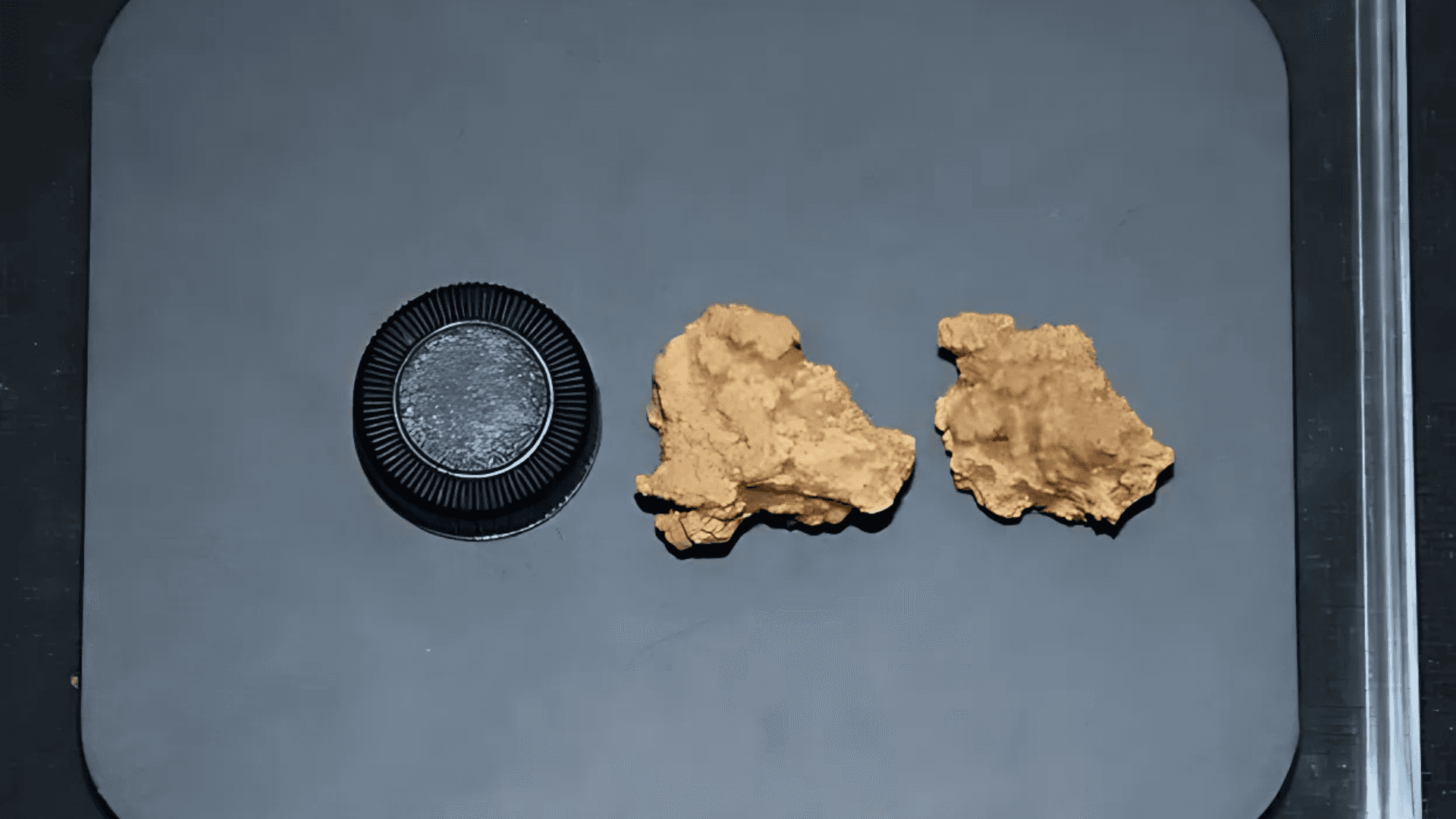Study Reveals Genetic Stability of Southern African Populations Over 10 Millennia
Study Reveals Genetic Stability of Southern African Populations Over 10 Millennia
Study Reveals Genetic Stability of Southern African Populations Over 10 Millennia
Oct 4, 2024
Oct 4, 2024
Oct 4, 2024

Illustrative image. Credit: Science Photo Library via Canva.
Illustrative image. Credit: Science Photo Library via Canva.
Illustrative image. Credit: Science Photo Library via Canva.
Discover how new DNA research reveals surprising genetic stability in Southern African populations over 10,000 years, highlighting the continuity between ancient peoples and modern San and Khoekhoe groups.
Discover how new DNA research reveals surprising genetic stability in Southern African populations over 10,000 years, highlighting the continuity between ancient peoples and modern San and Khoekhoe groups.
Discover how new DNA research reveals surprising genetic stability in Southern African populations over 10,000 years, highlighting the continuity between ancient peoples and modern San and Khoekhoe groups.
A new ancient DNA study unveils valuable information about the genetic evolution of Southern African populations, highlighting a surprising genetic stability over the past 10,000 years. The research, which analyzed samples from the Oakhurst rock shelter in southern Africa, compared genomes of ancient individuals with those of modern groups like the San and Khoekhoe.
Genetic Questions and Population Evolution in Southern Africa
Researchers analyzed the genomes of 13 individuals who lived between 10,000 and 1,300 years ago, using advanced DNA sequencing technologies to overcome the degradation of genetic material. The goal was to understand how the genetic heritage of these ancient populations evolved and how it relates to today's San and Khoekhoe groups.
Genetic Stability Over Millennia
One of the most surprising findings is that the populations inhabiting southern Africa 10,000 years ago share remarkable genetic similarities with today's San and Khoekhoe. That suggests an impressive genetic continuity, in contrast to regions like Europe and Asia, where large migrations significantly altered the population composition over the centuries.
The research indicates that southern Africa experienced little large-scale migration until about 1,200 years ago when new groups introduced herding, agriculture, and new languages. Before this period, the genetics of local populations remained largely stable.
Cultural and Genetic Interaction with New Groups
The landscape began to change with arriving migrants who brought technologies like herding and agriculture, initiating interactions with local hunter-gatherers around 1,200 years ago. While these interactions caused some genetic changes, the previous genetic foundation remained significant.
Expanding the Historical and Cultural Understanding of Southern African Populations
Despite significant advances, the study faced challenges, such as the limited number of genomes analyzed—only 13 individuals had their DNA successfully sequenced—and adverse environmental conditions that hindered the preservation of ancient DNA, requiring special extraction techniques that may have introduced certain biases. Researchers plan to expand their studies by sequencing more genomes from different areas of Southern Africa to overcome these limitations and broaden the understanding of the region's genetic history.
Additionally, they intend to deepen the analysis of interactions between migrant herders and hunter-gatherers, seeking to reveal more details about genetic and cultural changes over time. These studies aim to illuminate the genetic trajectory of the region's populations and enable a more accurate reconstruction of the migrations and interactions that shaped their genetic diversity.
—
Read the full research to know more about the fascinating genetic stability of Southern African populations and their historical connections. Click here to access the study.
A new ancient DNA study unveils valuable information about the genetic evolution of Southern African populations, highlighting a surprising genetic stability over the past 10,000 years. The research, which analyzed samples from the Oakhurst rock shelter in southern Africa, compared genomes of ancient individuals with those of modern groups like the San and Khoekhoe.
Genetic Questions and Population Evolution in Southern Africa
Researchers analyzed the genomes of 13 individuals who lived between 10,000 and 1,300 years ago, using advanced DNA sequencing technologies to overcome the degradation of genetic material. The goal was to understand how the genetic heritage of these ancient populations evolved and how it relates to today's San and Khoekhoe groups.
Genetic Stability Over Millennia
One of the most surprising findings is that the populations inhabiting southern Africa 10,000 years ago share remarkable genetic similarities with today's San and Khoekhoe. That suggests an impressive genetic continuity, in contrast to regions like Europe and Asia, where large migrations significantly altered the population composition over the centuries.
The research indicates that southern Africa experienced little large-scale migration until about 1,200 years ago when new groups introduced herding, agriculture, and new languages. Before this period, the genetics of local populations remained largely stable.
Cultural and Genetic Interaction with New Groups
The landscape began to change with arriving migrants who brought technologies like herding and agriculture, initiating interactions with local hunter-gatherers around 1,200 years ago. While these interactions caused some genetic changes, the previous genetic foundation remained significant.
Expanding the Historical and Cultural Understanding of Southern African Populations
Despite significant advances, the study faced challenges, such as the limited number of genomes analyzed—only 13 individuals had their DNA successfully sequenced—and adverse environmental conditions that hindered the preservation of ancient DNA, requiring special extraction techniques that may have introduced certain biases. Researchers plan to expand their studies by sequencing more genomes from different areas of Southern Africa to overcome these limitations and broaden the understanding of the region's genetic history.
Additionally, they intend to deepen the analysis of interactions between migrant herders and hunter-gatherers, seeking to reveal more details about genetic and cultural changes over time. These studies aim to illuminate the genetic trajectory of the region's populations and enable a more accurate reconstruction of the migrations and interactions that shaped their genetic diversity.
—
Read the full research to know more about the fascinating genetic stability of Southern African populations and their historical connections. Click here to access the study.
A new ancient DNA study unveils valuable information about the genetic evolution of Southern African populations, highlighting a surprising genetic stability over the past 10,000 years. The research, which analyzed samples from the Oakhurst rock shelter in southern Africa, compared genomes of ancient individuals with those of modern groups like the San and Khoekhoe.
Genetic Questions and Population Evolution in Southern Africa
Researchers analyzed the genomes of 13 individuals who lived between 10,000 and 1,300 years ago, using advanced DNA sequencing technologies to overcome the degradation of genetic material. The goal was to understand how the genetic heritage of these ancient populations evolved and how it relates to today's San and Khoekhoe groups.
Genetic Stability Over Millennia
One of the most surprising findings is that the populations inhabiting southern Africa 10,000 years ago share remarkable genetic similarities with today's San and Khoekhoe. That suggests an impressive genetic continuity, in contrast to regions like Europe and Asia, where large migrations significantly altered the population composition over the centuries.
The research indicates that southern Africa experienced little large-scale migration until about 1,200 years ago when new groups introduced herding, agriculture, and new languages. Before this period, the genetics of local populations remained largely stable.
Cultural and Genetic Interaction with New Groups
The landscape began to change with arriving migrants who brought technologies like herding and agriculture, initiating interactions with local hunter-gatherers around 1,200 years ago. While these interactions caused some genetic changes, the previous genetic foundation remained significant.
Expanding the Historical and Cultural Understanding of Southern African Populations
Despite significant advances, the study faced challenges, such as the limited number of genomes analyzed—only 13 individuals had their DNA successfully sequenced—and adverse environmental conditions that hindered the preservation of ancient DNA, requiring special extraction techniques that may have introduced certain biases. Researchers plan to expand their studies by sequencing more genomes from different areas of Southern Africa to overcome these limitations and broaden the understanding of the region's genetic history.
Additionally, they intend to deepen the analysis of interactions between migrant herders and hunter-gatherers, seeking to reveal more details about genetic and cultural changes over time. These studies aim to illuminate the genetic trajectory of the region's populations and enable a more accurate reconstruction of the migrations and interactions that shaped their genetic diversity.
—
Read the full research to know more about the fascinating genetic stability of Southern African populations and their historical connections. Click here to access the study.
Compartilhar em:
Compartilhar em:
Ver Também
Ver Também

Estudo Revela que o Microbioma Humano é Altamente Individualizado
Sep 2, 2024

Estrutura em Forma de Rosquinha no Núcleo da Terra Revela Segredos sobre o Campo Magnético
Sep 2, 2024

Estudo Sugere que 'Hotspots' de Fósseis na África Distorcem a Visão da Evolução Humana
Sep 3, 2024

Ruído Incomum na Starliner de Boeing Intriga Astronauta da NASA
Sep 3, 2024

Relatório da Carbon Brief Aponta que 2024 Pode Ser o Ano Mais Quente da História
Sep 4, 2024

Clima Determina a Distribuição de Mamíferos, Revela Estudo da Universidade Estadual da Carolina do Norte
Sep 4, 2024

Como os Direitos Humanos Podem Salvar Recifes de Coral e Responsabilizar Governos
Oct 2, 2024

Nove Lugares Míticos Que Podem Ter Existido, Segundo Descobertas Arqueológicas
Oct 3, 2024

Estudo Revela Estabilidade Genética de Populações da África Austral por 10 Milênios
Oct 4, 2024

Análise de DNA em Múmias Chinesas de 3.600 Anos Revela Queijo Mais Antigo do Mundo
Oct 7, 2024

Estudo Demonstra Semelhanças Entre a Puberdade de Adolescentes da Idade do Gelo e Jovens Modernos
Oct 8, 2024

Estudo Indica Maior Incidência de Asma e Rinite Alérgica em Pessoas Nascidas no Outono e Inverno na Finlândia
Oct 9, 2024

Escavação na Dinamarca Revela 50 Esqueletos Viking Incrivelmente Preservados
Oct 10, 2024

Nascimentos na UE Caem para Menos de 4 Milhões pela Primeira Vez desde 1960
Oct 11, 2024

Estudo Aponta que Duplicação do Gene AMY1, Relacionado à Digestão de Amido, Precede a Agricultura
Oct 14, 2024

Revolução XRISM: Novas Descobertas sobre Buracos Negros Supermassivos
Oct 15, 2024

Colapso da Plataforma de Gelo Conger: Alerta para a Antártica Oriental
Dec 20, 2024

Estudo Relaciona Poluição do Ar ao Risco de Tromboembolismo Venoso
Dec 20, 2024

As Emoções e o Corpo Humano: Conexões Milenares nos Textos Neo-Assírios
Dec 20, 2024

Ambiente Potencialmente Habitável em Marte é Descoberto pelo Perseverance
Dec 20, 2024

Estudo Revela que o Microbioma Humano é Altamente Individualizado
Sep 2, 2024

Estrutura em Forma de Rosquinha no Núcleo da Terra Revela Segredos sobre o Campo Magnético
Sep 2, 2024

Estudo Sugere que 'Hotspots' de Fósseis na África Distorcem a Visão da Evolução Humana
Sep 3, 2024

Ruído Incomum na Starliner de Boeing Intriga Astronauta da NASA
Sep 3, 2024

Relatório da Carbon Brief Aponta que 2024 Pode Ser o Ano Mais Quente da História
Sep 4, 2024

Clima Determina a Distribuição de Mamíferos, Revela Estudo da Universidade Estadual da Carolina do Norte
Sep 4, 2024

Como os Direitos Humanos Podem Salvar Recifes de Coral e Responsabilizar Governos
Oct 2, 2024

Nove Lugares Míticos Que Podem Ter Existido, Segundo Descobertas Arqueológicas
Oct 3, 2024

Estudo Revela Estabilidade Genética de Populações da África Austral por 10 Milênios
Oct 4, 2024

Análise de DNA em Múmias Chinesas de 3.600 Anos Revela Queijo Mais Antigo do Mundo
Oct 7, 2024

Estudo Demonstra Semelhanças Entre a Puberdade de Adolescentes da Idade do Gelo e Jovens Modernos
Oct 8, 2024

Estudo Indica Maior Incidência de Asma e Rinite Alérgica em Pessoas Nascidas no Outono e Inverno na Finlândia
Oct 9, 2024

Escavação na Dinamarca Revela 50 Esqueletos Viking Incrivelmente Preservados
Oct 10, 2024

Nascimentos na UE Caem para Menos de 4 Milhões pela Primeira Vez desde 1960
Oct 11, 2024

Estudo Aponta que Duplicação do Gene AMY1, Relacionado à Digestão de Amido, Precede a Agricultura
Oct 14, 2024

Revolução XRISM: Novas Descobertas sobre Buracos Negros Supermassivos
Oct 15, 2024

Colapso da Plataforma de Gelo Conger: Alerta para a Antártica Oriental
Dec 20, 2024

Estudo Relaciona Poluição do Ar ao Risco de Tromboembolismo Venoso
Dec 20, 2024

As Emoções e o Corpo Humano: Conexões Milenares nos Textos Neo-Assírios
Dec 20, 2024

Ambiente Potencialmente Habitável em Marte é Descoberto pelo Perseverance
Dec 20, 2024